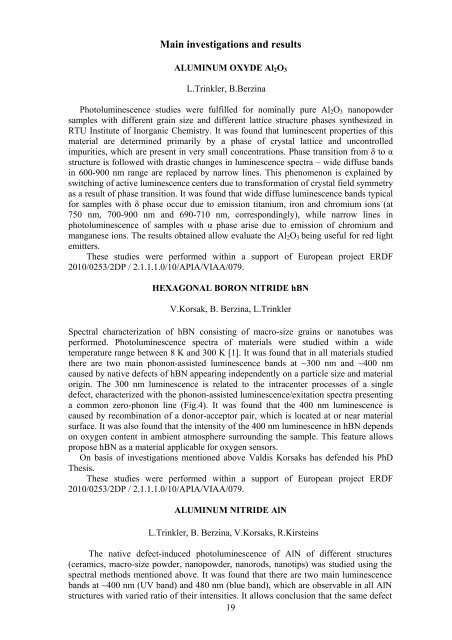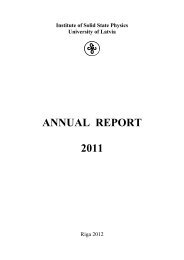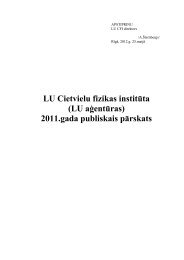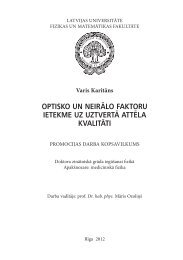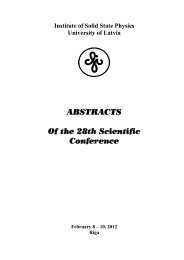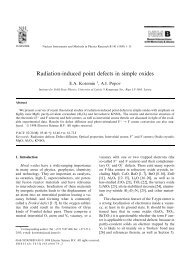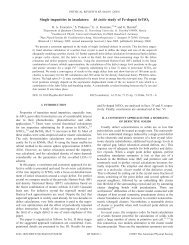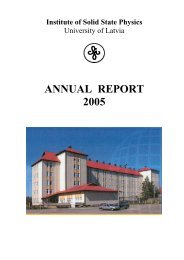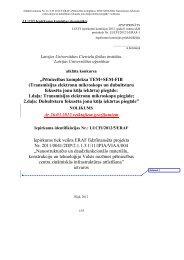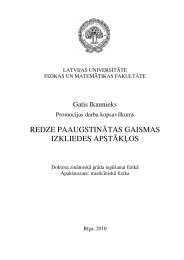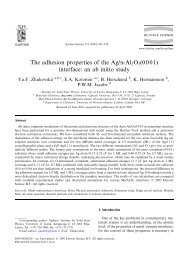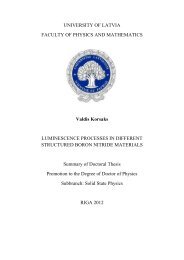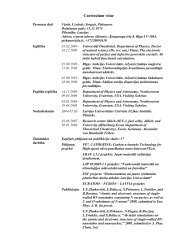Annual Report 2012 - Latvijas Universitātes Cietvielu fizikas institūts
Annual Report 2012 - Latvijas Universitātes Cietvielu fizikas institūts
Annual Report 2012 - Latvijas Universitātes Cietvielu fizikas institūts
You also want an ePaper? Increase the reach of your titles
YUMPU automatically turns print PDFs into web optimized ePapers that Google loves.
Main investigations and results<br />
ALUMINUM OXYDE Al 2 O 3<br />
L.Trinkler, B.Berzina<br />
Photoluminescence studies were fulfilled for nominally pure Al 2 O 3 nanopowder<br />
samples with different grain size and different lattice structure phases synthesized in<br />
RTU Institute of Inorganic Chemistry. It was found that luminescent properties of this<br />
material are determined primarily by a phase of crystal lattice and uncontrolled<br />
impurities, which are present in very small concentrations. Phase transition from δ to α<br />
structure is followed with drastic changes in luminescence spectra – wide diffuse bands<br />
in 600-900 nm range are replaced by narrow lines. This phenomenon is explained by<br />
switching of active luminescence centers due to transformation of crystal field symmetry<br />
as a result of phase transition. It was found that wide diffuse luminescence bands typical<br />
for samples with δ phase occur due to emission titanium, iron and chromium ions (at<br />
750 nm, 700-900 nm and 690-710 nm, correspondingly), while narrow lines in<br />
photoluminescence of samples with α phase arise due to emission of chromium and<br />
manganese ions. The results obtained allow evaluate the Al 2 O 3 being useful for red light<br />
emitters.<br />
These studies were performed within a support of European project ERDF<br />
2010/0253/2DP / 2.1.1.1.0/10/APIA/VIAA/079.<br />
HEXAGONAL BORON NITRIDE hBN<br />
V.Korsak, B. Berzina, L.Trinkler<br />
Spectral characterization of hBN consisting of macro-size grains or nanotubes was<br />
performed. Photoluminescence spectra of materials were studied within a wide<br />
temperature range between 8 K and 300 K [1]. It was found that in all materials studied<br />
there are two main phonon-assisted luminescence bands at ~300 nm and ~400 nm<br />
caused by native defects of hBN appearing independently on a particle size and material<br />
origin. The 300 nm luminescence is related to the intracenter processes of a single<br />
defect, characterized with the phonon-assisted luminescence/exitation spectra presenting<br />
a common zero-phonon line (Fig.4). It was found that the 400 nm luminescence is<br />
caused by recombination of a donor-acceptor pair, which is located at or near material<br />
surface. It was also found that the intensity of the 400 nm luminescence in hBN depends<br />
on oxygen content in ambient atmosphere surrounding the sample. This feature allows<br />
propose hBN as a material applicable for oxygen sensors.<br />
On basis of investigations mentioned above Valdis Korsaks has defended his PhD<br />
Thesis.<br />
These studies were performed within a support of European project ERDF<br />
2010/0253/2DP / 2.1.1.1.0/10/APIA/VIAA/079.<br />
ALUMINUM NITRIDE AlN<br />
L.Trinkler, B. Berzina, V.Korsaks, R.Kirsteins<br />
The native defect-induced photoluminescence of AlN of different structures<br />
(ceramics, macro-size powder, nanopowder, nanorods, nanotips) was studied using the<br />
spectral methods mentioned above. It was found that there are two main luminescence<br />
bands at ~400 nm (UV band) and 480 nm (blue band), which are observable in all AlN<br />
structures with varied ratio of their intensities. It allows conclusion that the same defect<br />
19


